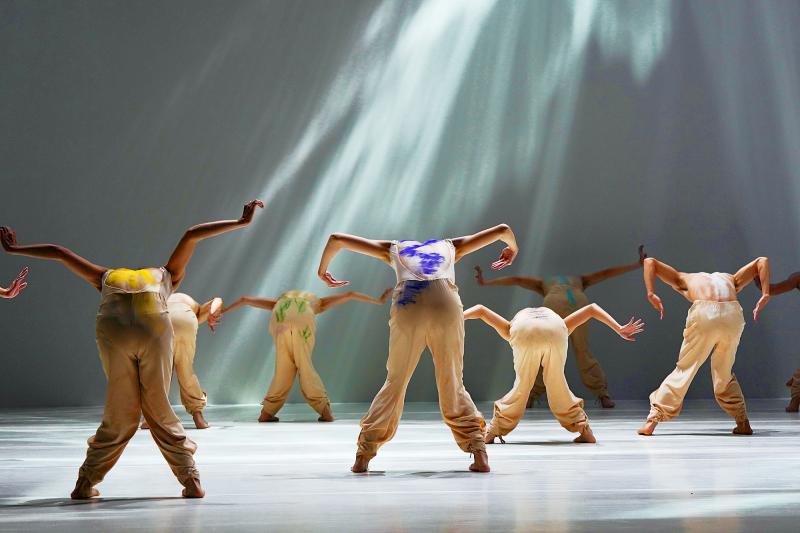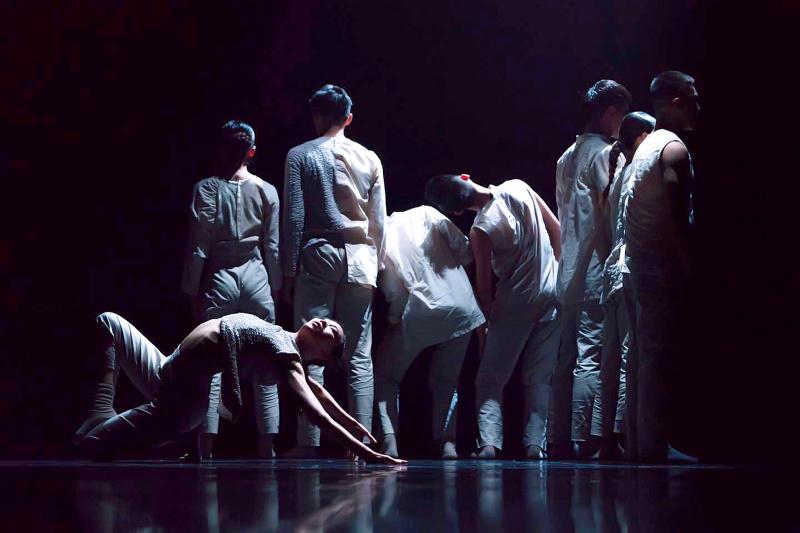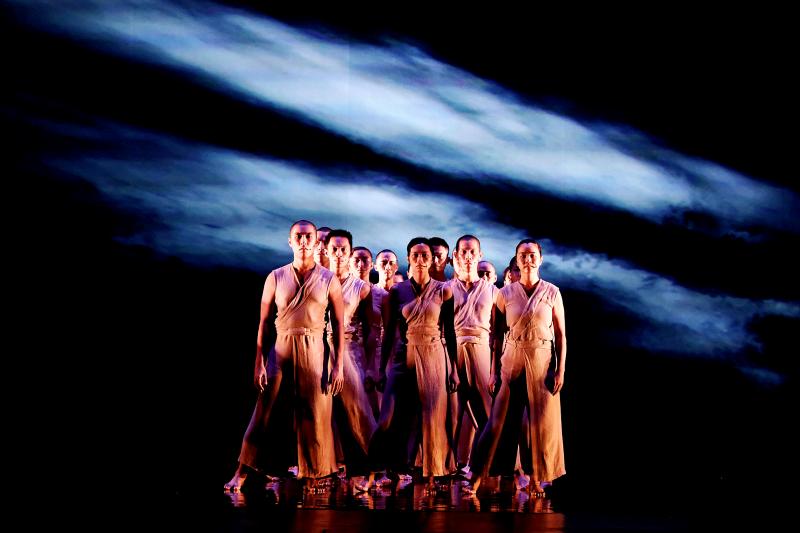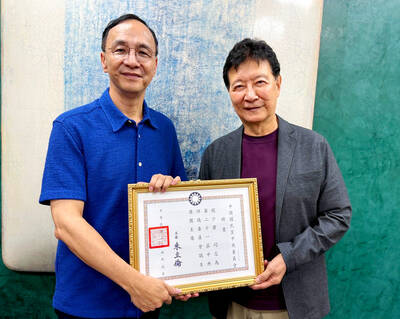In a year when so many theaters and performing arts companies were forced to shutter due to the COVID-19 pandemic, audiences and artists in Taiwan were able to enjoy a relative degree of normality, and I felt ridiculously fortunate to not only be able to see shows, but see so many good ones.
While many productions exceeded expectations, I decided against doing a Top 10 dance list, choosing instead to focus on the development of choreographers and companies shown through their new works or revivals.
However, if there were a list, Cheng Tsung-lun’s (鄭宗龍) Sounding Light (定光), his first full-length work for Cloud Gate Dance Theatre (雲門舞集) as artistic director, would be on top.

Photo: CNA
Sounding Light, which premiered at the National Theater in Taipei on Oct. 1, is deceptively sparse, yet filled with intriguing movement, light patterns and sounds that highlight Cheng’s continuing development of a unique movement vocabulary and stage artistry.
It is also a testament to the depth of talent Cheng has to work with in a reformatted company made up of veterans of Cloud Gate and the now-suspended Cloud Gate 2 (雲門2).
Depth of talent is the hallmark of another company that grew out of Cloud Gate: the Bulareyaung Dance Company (BDC, 布拉瑞揚舞團), whose founder, Bulareyaung Pagarlava (Bula) started his career as a Cloud Gate dancer and became CG2’s first resident choreographer.

Photo courtesy of Tjimur Dance Theatre
He returned to Taitung County in 2014 to establish his own troupe and focus on the development of dancers from indigenous communities, and BDC marked its fifth anniversary this year with LIMA, a weekend sampler of works at the Cloud Gate Theater in New Taipei City.
The sold-out run turned out to be a massive love fest between the company’s multi-talented men, who dance, sing and act with such exuberance, yet still wring tears in the more poignant moments, and their fans.
I caught the first show, Yes or NO (#是否), which was just as good as last year’s premiere, but left me wishing I could have dropped everything else to see the rest of the weekend’s performances.

Photo courtesy of Hung Dance
Two shows by BDC’s older counterpart from Pingtung County, the family-run Tjimur Dance Theatre (蒂摩爾古薪舞集) also stole my heart: a restaging last month of Varhung — Heart to Heart (Varhung — 心事誰人知) at the National Kaohsiung Center for the Arts’ Dance Platform, and their new production, Go Paiwan (去排灣), at the National Experimental Theater in Taipei at the beginning of this month.
For Go Paiwan, artistic director Ljuzem Madiljin for the first time invited a guest choreographer to work with her choreographer brother, Baru Madiljin, to develop a “dance theater” piece.
Lin Wen-chung’s (林文中) contribution help create a show that celebrates the company’s traditional dance and singing strengths while embracing audience participation and smartphone technology. It proved to be terrific fun.

Photo: AFP
Lai Hung-chung (賴翃中) also moved beyond his comfort zone with his latest work for his Hung Dance (翃舞製作) troupe, See You (再 見), which premiered at the Taipei Shuiyuan Theater on Nov. 6.
Set on eight dancers, it is a moving exploration of life and loss, and demonstrates Lai’s ability craft more than the duets and trios that he is known for.
Two revivals that were actually almost complete restagings, while vastly different in size and scope, were knock-outs: U-Theatre’s (優人神鼓) River Journey (與你共舞) at the National Theater last weekend and Taipei Dance Forum’s (舞蹈空間) Red and White, zoom-in (紅與白zoom-in版) by choreographer Cheng Yi-wen (鄭伊雯) and theater director Liu Shou-yao (劉守曜) in September.
Two memorable shows from the Taipei Arts Festival were Berlin-based Singaporean artist Choy Ka-fai’s (徐家輝) CosmicWander: OnGon+NeZha and from Thailand, Pichet Klunchun Dance Company’s No. 60.
And while not a dance production, I cannot end this round-up without mentioning Formosa Circus Art’s (FOCA, 福爾摩沙馬戲團) Moss (苔痕), a collaboration with Germany-based dancer/choreographers Jan Mollmer and Tien Tsai-wei (田采薇).
A combination of circus acrobatics and dance theater, it is an outstanding show about friendship and memories, and a proof of FOCA’s commitment to challenge boundaries and preconceptions.

Late last month Philippines Foreign Affairs Secretary Theresa Lazaro told the Philippine Senate that the nation has sufficient funds to evacuate the nearly 170,000 Filipino residents in Taiwan, 84 percent of whom are migrant workers, in the event of war. Agencies have been exploring evacuation scenarios since early this year, she said. She also observed that since the Philippines has only limited ships, the government is consulting security agencies for alternatives. Filipinos are a distant third in overall migrant worker population. Indonesia has over 248,000 workers, followed by roughly 240,000 Vietnamese. It should be noted that there are another 170,000

Enter the Dragon 13 will bring Taiwan’s first taste of Dirty Boxing Sunday at Taipei Gymnasium, one highlight of a mixed-rules card blending new formats with traditional MMA. The undercard starts at 10:30am, with the main card beginning at 4pm. Tickets are NT$1,200. Dirty Boxing is a US-born ruleset popularized by fighters Mike Perry and Jon Jones as an alternative to boxing. The format has gained traction overseas, with its inaugural championship streamed free to millions on YouTube, Facebook and Instagram. Taiwan’s version allows punches and elbows with clinch striking, but bans kicks, knees and takedowns. The rules are stricter than the

“Far from being a rock or island … it turns out that the best metaphor to describe the human body is ‘sponge.’ We’re permeable,” write Rick Smith and Bruce Lourie in their book Slow Death By Rubber Duck: The Secret Danger of Everyday Things. While the permeability of our cells is key to being alive, it also means we absorb more potentially harmful substances than we realize. Studies have found a number of chemical residues in human breast milk, urine and water systems. Many of them are endocrine disruptors, which can interfere with the body’s natural hormones. “They can mimic, block

Next week, candidates will officially register to run for chair of the Chinese Nationalist Party (KMT). By the end of Friday, we will know who has registered for the Oct. 18 election. The number of declared candidates has been fluctuating daily. Some candidates registering may be disqualified, so the final list may be in flux for weeks. The list of likely candidates ranges from deep blue to deeper blue to deepest blue, bordering on red (pro-Chinese Communist Party, CCP). Unless current Chairman Eric Chu (朱立倫) can be convinced to run for re-election, the party looks likely to shift towards more hardline